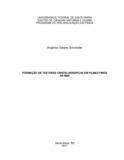| dc.creator | Schneider, Angélica Daiane | |
| dc.date.accessioned | 2018-07-30T19:17:04Z | |
| dc.date.available | 2018-07-30T19:17:04Z | |
| dc.date.issued | 2017-12-20 | |
| dc.identifier.uri | http://repositorio.ufsm.br/handle/1/13950 | |
| dc.description.abstract | Niobium nitride (NbN) thin films can be hard and resistant not only to mechanical wear but
also to chemically aggressive atmospheres. Additionally, they can present a superconducting
transition in temperatures that are larger than classical BCS materials. But all these
properties of the NbN thin film, and its performance in devices, strongly depends not only
on its crystallographic structure, but also on the presence of crystallographic textures.
In this work we approach the texture formation as a function of the thickness, in NbN thin
films prepared by reactive magnetron sputtering onto Si substrates held at 300, 400, and
500°C. A transmition electron microscopy (TEM) image shows a columnar type morphology
for the NbN deposited under our experimental conditions. The crystal structure and degree
of texturization, for each thickness and temperature, were stablished by X-Ray diffractometry
in the Bragg-Brentano configuration.
Independent of the temperature of the substrate, two crystallographic textures of the cubic
NbN ((200) and (111)) can be identified, but with contributions to the total volume that
depends on the film thickness. Up to 300 nm, value that is almost independent of the substrate
temperature, the grow of NbN with (111) planes parallel to the substrate dominates.
Above this point, the picture inverts, and the material is mainly deposited along the h200i
direction. This two-steps process is present even for the films deposite at 500°C, where the
invertion in the process occurs together with the formation of NbN with hexagonal symmetry.
Althought a similar behavior have been reported to TiN, this process was not up to now
identified in NbN thin films.
The results are discussed in terms of the models traditionally used for explain the formation
of textures in nitrides. | eng |
| dc.description.sponsorship | Conselho Nacional de Pesquisa e Desenvolvimento Científico e Tecnológico - CNPq | por |
| dc.language | por | por |
| dc.publisher | Universidade Federal de Santa Maria | por |
| dc.rights | Attribution-NonCommercial-NoDerivatives 4.0 International | * |
| dc.rights.uri | http://creativecommons.org/licenses/by-nc-nd/4.0/ | * |
| dc.subject | Nitreto de nióbio | por |
| dc.subject | Orientação preferencial | por |
| dc.subject | Filmes finos | por |
| dc.subject | Niobium nitride | eng |
| dc.subject | Preferred orientation | eng |
| dc.subject | Thin films | eng |
| dc.title | Formação de texturas cristalográficas em filmes finos de NbN | por |
| dc.title.alternative | Formation of crystallographic textures in thin films of NbN | eng |
| dc.type | Dissertação | por |
| dc.description.resumo | Filmes finos de nitreto de nióbio (NbN) podem ter alta dureza e resistência ao desgaste
mecânico e à atmosferas quimicamente reativas. Além disso, podem apresentar transição
supercondutora para temperaturas relativamente altas se comparadas a de outros supercondutores
BCS tradicionais. Entretanto, suas propriedades e seu desempenho em dispositivos
depende muito, tanto da estrutura cristalográfica assumida pelo material, como da
formação de texturas cristalográficas.
Neste trabalho avaliamos a formação de texturas em função da espessura em filmes finos
preparados por magnetron sputtering reativo sobre substratos de Si mantidos durante a
deposição a 300, 400 e 500°C. Uma imagem de microscopia de transmissão eletrônica
(TEM) mostra a formação de filmes com estrutura colunar. A estrutura cristalográfica e
as texturas, para cada espessura e temperatura de deposição foram estabelecidas por
difratometria de RX na configuração Bragg-Brentano.
Para todas as temperaturas, duas orientações preferenciais do NbN cúbico ((200) e (111))
aparecem, mas seus percentuais sobre o volume total da amostra variam com a espessura.
Até uma espessura próxima de 300 nm, valor que dependente pouco da temperatura, a
formação do filme com planos (111) paralelos ao substrato é favorecida. Para espessuras
maiores o processo é invertido e os cristais com direção h200i passam a predominar no
crescimento. Este processo em duas etapas mantém mesmo a 500°C, onde é inversão
é acompanhada da formação de NbN com estrutura hexagonal. Tal evolução em duas
etapas, semelhante a outra identificada em TiN, não foi até aqui reportada na literatura
para filmes finos de NbN.
Os resultados são discutidos em termos dos modelos tradicionalmente utilizados para explicar
a formação de texturas em nitretos. | por |
| dc.contributor.advisor1 | Dorneles, Lucio Strazzabosco | |
| dc.contributor.advisor1Lattes | http://lattes.cnpq.br/7244173039310066 | por |
| dc.contributor.referee1 | Tumelero, Milton Andre | |
| dc.contributor.referee1Lattes | http://lattes.cnpq.br/0041450594172893 | por |
| dc.contributor.referee2 | Zimmer, Fábio Mallmann | |
| dc.contributor.referee2Lattes | http://lattes.cnpq.br/6328420212181284 | por |
| dc.creator.Lattes | http://lattes.cnpq.br/9304625088554861 | por |
| dc.publisher.country | Brasil | por |
| dc.publisher.department | Física | por |
| dc.publisher.initials | UFSM | por |
| dc.publisher.program | Programa de Pós-Graduação em Física | por |
| dc.subject.cnpq | CNPQ::CIENCIAS EXATAS E DA TERRA::FISICA | por |
| dc.publisher.unidade | Centro de Ciências Naturais e Exatas | por |



